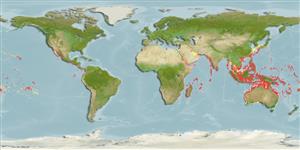Common names from other countries
Environment: milieu / climate zone / depth range / distribution range
বাস্তুসংস্থান
; গভীরতার পরিসীমা 1 - 56 m (Ref. 100987). Tropical
Indo-Pacific.
Length at first maturity / আকৃতি / ওজন / Age
Maturity: Lm ? range ? - ? cm Max length : 7.0 cm SHL পুরুষ/ লিঙ্গ অনিধর্ারিত ; (Ref. 349); common length : 5.0 cm SHL পুরুষ/ লিঙ্গ অনিধর্ারিত ; (Ref. 349)
Mainly collected for shellcraft because of the highly variable colour patterns of its shell (Ref. 349). Common in subtidal zones (Ref. 349). Also in coral sand of shallow waters (Ref. 799) and muddy sand (Ref. 130068). Members of the family Strombidae are mostly herbivores , browsing on delicate algae, or swallowing sand and detritus to digest the decomposing plant matter (Ref. 349).
Life cycle and mating behavior
পরিপক্কতা | প্রজনন | ডিম ছাড়া | ডিমসমূহ | ডিম্বধারন ক্ষমতা | শুককীট
Members of the order Neotaenioglossa are mostly gonochoric and broadcast spawners. Life cycle: Embryos develop into planktonic trocophore larvae and later into juvenile veligers before becoming fully grown adults.
Poutiers, J.M. 1998. (Ref. 349)
IUCN Red List Status (Ref. 130435)
CITES status (Ref. 108899)
Not Evaluated
Not Evaluated
Threat to humans
Harmless
Human uses
| FishSource |
হাতিয়ার
আরো তথ্য
Age/Size
বৃদ্ধি
Length-weight
Length-length
বহিঃ অঙ্গ সংস্থান
শুককীট
প্রাচুর্য
ইন্টারনেট সুত্র
Estimates based on models
Preferred temperature
(Ref.
115969): 24.5 - 29, mean 28 (based on 1170 cells).
Vulnerability
Low vulnerability (10 of 100).
Price category
Unknown.
